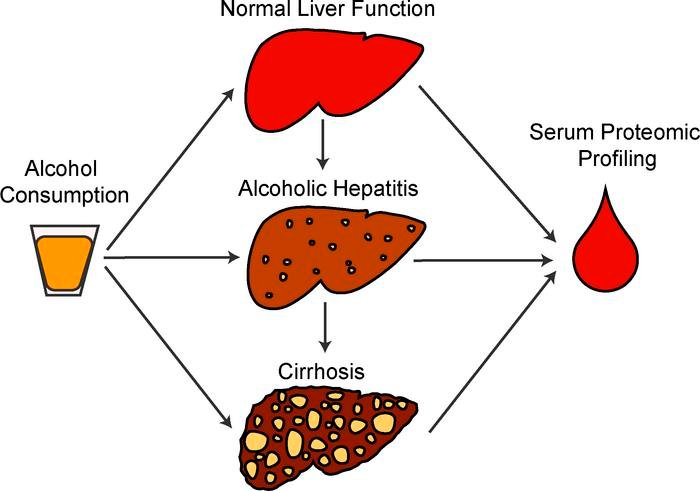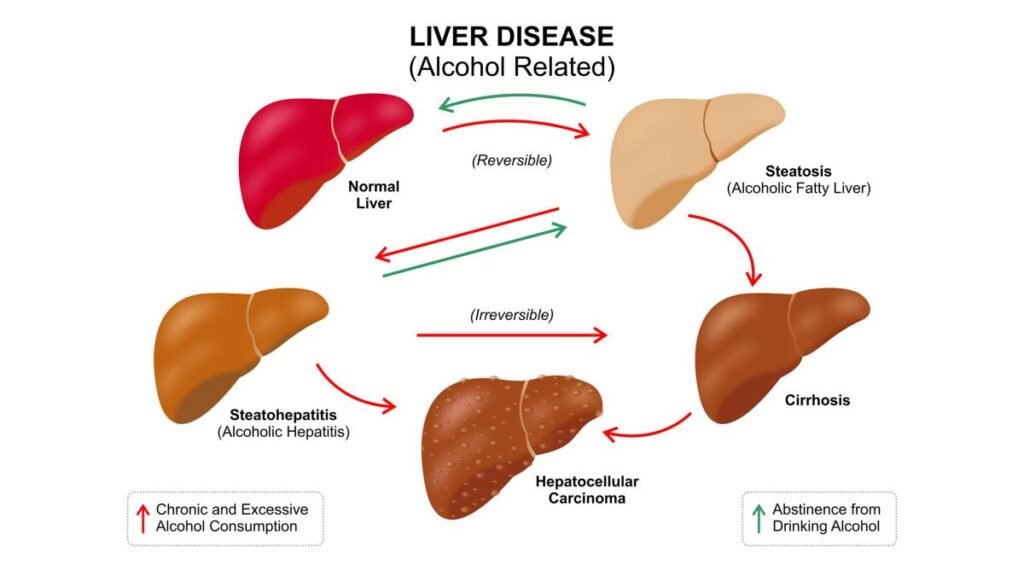Alcoholic hepatitis
Alcoholic hepatitis is a condition where the liver becomes swollen and inflamed due to alcohol use. Drinking alcohol damages liver cells, and over time, this damage can lead to serious liver problems.
The condition is most common in people who drink heavily for many years. However, the connection isn’t always straightforward—some heavy drinkers never develop alcoholic hepatitis, while others may get it even with less alcohol use.
If you are diagnosed with alcoholic hepatitis, it’s critical to stop drinking alcohol. Continuing to drink greatly increases the risk of severe liver damage and even death.
The liver is a large organ located beneath the ribs on the right side of the abdomen. It plays many important roles, including:
Filtering toxins and waste from the body
Producing bile to help digest food
Storing sugar (glycogen) for energy
Hepatitis means inflammation of the liver, which leads to liver cell injury and cell death.

Symptoms
The most common sign of alcoholic hepatitis is yellowing of the skin and whites of the eyes, called jaundice. The yellowing of the skin might be harder to see on Black and brown people.
Other symptoms include:
- Loss of appetite.
- Nausea and vomiting.
- Belly tenderness.
- Fever, often low grade.
- Tiredness and weakness.
People with alcoholic hepatitis tend to be malnourished. Drinking large amounts of alcohol keeps people from being hungry. And heavy drinkers get most of their calories from alcohol.
Other symptoms that happen with severe alcoholic hepatitis include:
- Fluid buildup in the belly, called ascites.
- Being confused and acting oddly due to a buildup of toxins. The healthy liver breaks these toxins down and gets rid of them.
- Kidney and liver failure.

When to see a doctor
Alcoholic hepatitis is a serious, often deadly disease.
See a healthcare professional if you:
- Have symptoms of alcoholic hepatitis.
- Can’t control your drinking.
- Want help cutting back on your drinking.
Causes of Alcoholic Hepatitis
Alcoholic hepatitis develops when the liver is damaged by alcohol. Exactly how alcohol harms the liver—and why it only affects some heavy drinkers—isn’t fully understood. But several factors are known to play a role:
Toxic byproducts of alcohol: When the body breaks down alcohol, it produces harmful chemicals. These chemicals cause inflammation (swelling) and destroy liver cells.
Scarring of the liver: As healthy cells are replaced by scar tissue, the liver becomes less able to do its job. This condition, called cirrhosis, is permanent and is the final stage of alcoholic liver disease.
Other factors that can contribute include:
Other liver diseases: Alcohol can worsen existing liver problems. For example, people with hepatitis C who drink—even a small amount—are more likely to develop scarring.
Poor nutrition: Many heavy drinkers don’t eat enough healthy foods. Alcohol also interferes with how the body uses nutrients, which can further damage liver cells.
Risk factors
The biggest risk factor for alcoholic hepatitis is how much alcohol you drink. However, there isn’t a clear amount of alcohol that always causes the disease.
Most people diagnosed with alcoholic hepatitis have been drinking at least seven drinks a day for 20 years or more. This could mean:
7 glasses of wine
7 beers
7 shots of spirits
Still, the condition can also occur in people who drink less, especially if they have other risk factors, such as:
Sex: Women are more likely to develop alcoholic hepatitis, possibly because their bodies process alcohol differently.
Obesity: Being overweight and drinking heavily raises the risk and also increases the chance of developing liver scarring (cirrhosis).
Genes: Some people may be more genetically prone to alcohol-related liver disease.
Race and ethnicity: Research suggests that Black and Hispanic people may have a higher risk.
Binge drinking: Drinking large amounts in a short period (five or more drinks within two hours for men, four or more for women) may raise the risk.

Complications
Alcoholic hepatitis can lead to serious problems when scar tissue builds up in the liver. This scarring slows blood flow and increases pressure in the portal vein (a major blood vessel that carries blood to the liver). As a result, toxins can build up in the body and cause complications such as:
Enlarged veins (varices): When blood can’t move easily through the liver, it backs up into veins in the stomach and esophagus (the food pipe). These veins have thin walls and can burst, causing dangerous bleeding that needs emergency care.
Ascites (ah-SITE-ees): Fluid buildup in the belly. Sometimes the fluid gets infected and needs treatment with antibiotics. While not always life-threatening, ascites usually means the liver is badly scarred.
Hepatic encephalopathy: When the liver can’t remove toxins from the blood, they affect the brain. This can cause confusion, drowsiness, slurred speech, or even coma in severe cases.
Kidney failure: A damaged liver can reduce blood flow to the kidneys, leading to kidney damage.
Cirrhosis: Severe, permanent scarring of the liver that can eventually cause liver failure.

Prevention
While there’s no guaranteed way to avoid alcoholic hepatitis, you can lower your risk by taking the following steps:
Limit or avoid alcohol: For healthy adults, moderate drinking means:
Up to 1 drink a day for women
Up to 2 drinks a day for men
The only sure way to prevent alcoholic hepatitis is to not drink alcohol at all.
Protect yourself from hepatitis C: Hepatitis C is a viral infection that damages the liver and can lead to cirrhosis. If you have hepatitis C, drinking alcohol—even small amounts—greatly increases your risk of serious liver damage.
Be careful with medicines and alcohol:
Always check with your healthcare provider before drinking alcohol if you take prescription medicines.
Read the warning labels on over-the-counter drugs.
Never drink alcohol when using medicines that warn against it, such as pain relievers containing acetaminophen (Tylenol and others), since this combination can be very harmful to the liver.
